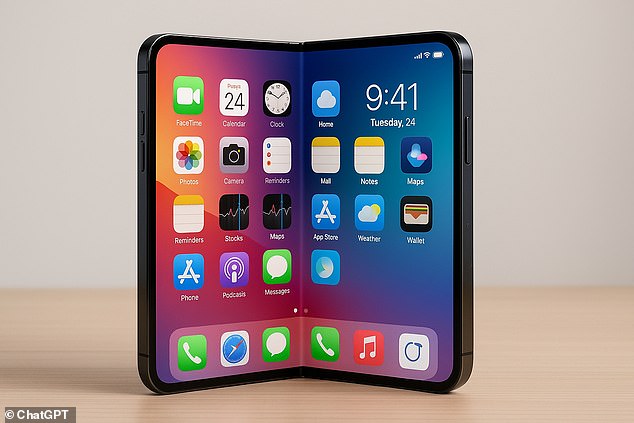We already know Apple is secretly preparing its first ever foldable iPhone.
But now, keen tech fans have just got a new hint at what it may look like.
According to a leak from a veteran Apple analyst, Mark Gurman of Bloomberg, the ‘iPhone Fold’ will see some major design changes.
And Mr Gurman claims that anyone who tries the new foldable device will ‘never want to go back’.
iPhone Fold, as it’s being referred to, will have four cameras, a barely-noticeable crease and Touch ID, the leaker claims.
Although it has been rumoured for years, it now looks almost certain that Apple is planning to unveil the folding iPhone in September 2026.
Early rumours suggested that the device would use a vertical ‘flip-phone’ style design, but it appears that Apple will opt for a larger, horizontal book-style phone.
That means the foldable iPhone will likely look a lot more like Samsung’s Galaxy Z Fold 7, rather than something like the Motorola Razr 60 Ultra.

According to a leak from Bloomberg’s Mark Gurman, the new folding iPhone will open up like a book and ditch Face ID in favour of Touch ID to keep the display as thin as possible. Pictured: An AI-generated impression of what the device might look like

The folding iPhone is expected to have a similar design to the Samsung Galaxy Z Fold 7 (pictured), which opens like a book
One of the biggest changes could be that the folding device will ditch Face ID in favour of Touch ID – a major break from every recent iPhone model.
Touch ID uses a fingerprint reader to unlock the device, while Face ID uses facial recognition.
According to Mr Gurman, the sensors required for Face ID are simply too large to fit Apple’s new radically thin design.
Instead of using their face to open the device, Apple users will instead use a fingerprint to access their device.
For the same reason, Apple is reportedly planning to drop the SIM slot, meaning that the device will be eSIM.
Earlier rumours have suggested that the folding iPhone is targeting a thickness of 4.8mm unfolded, which would make it a bit thicker than the Galaxy Z Fold 7 (4.2mm) but significantly slimmer than the Google Pixel 10 Pro Fold, which comes in at 5.2mm.
However, given that the thinner Galaxy Z Fold 7 does have a SIM tray, it’s not entirely clear why Apple would insist on going eSIM only.
As with earlier rumours, Mr Gurman also claims that the folding iPhone will feature four cameras: two on the back, one on the front display, and one on the inner display.
These main cameras are also likely to come in at 48 megapixels, the same as the main camera on the iPhone 16 Pro.

Although it has not been officially confirmed, it is believed that Apple will unveil the folding iPhone in September next year
At an expected thickness of 4.8mm unfolded, the folding iPhone will be significantly thinner than the similarly designed Google Pixel 10 Pro Fold (pictured), which measures 5.2mm thick
Once seen as a pioneer of smartphone design, Apple has been noticeably behind the curve on foldables.
Companies like Motorola, Samsung, Google, and Chinese firms like Xiaomi have already released multiple generations of foldables.
According to Mr Gurman, this delay has been caused by Apple’s obsessive quest to reduce the size of the screen crease.
On almost all folding devices, the crease over the hinge where the screen folds is visible even when the display is unfolded.
Mr Gurman says: ‘Apple recently made a change to the screen technology in its foldable iPhone.’
Instead of using an ‘on-cell touch sensor’ which leaves an air gap between the screen and the cover, Apple is opting for an ‘in-cell touch screen’.
This is much closer to the display technology found in iPhones today and should make the crease much less obvious while also improving touch accuracy.
Not much else is known about the folding iPhone’s design, but Mr Gurman suggests that it’ll be available in two colours: black and white.

According to Apple analysts, the iPhone fold will come after the release of the iPhone 17 and iPhone 17 Pro this year, which may come in some unusual colours. Pictured: A digital render of what the iPhone 17 Pro may look like

Apple is also expected to release the iPhone Air. Leaked images by tipsters show the iPhone Air (right) next to a model of an iPhone 17 (left)
Additionally, the device may include Apple’s own C2 modem chipset, rather than the Qualcomm chips found in most other smartphones.
However, until we see the device next year, Apple’s plans may well change, and there isn’t much that can be said for certain.
These leaked details of the folding iPhone come ahead of what Mr Gurman calls ‘three straight years of major iPhone redesigns’.
Read More
Apple TV+ deals devastating price rise to millions – as furious users threaten to CANCEL

This will likely begin with the release of the exceptionally thin iPhone Air, to be launched alongside the iPhone 17 this September.
This release will supposedly be followed by the folding iPhone in 2026 and, finally, the release of the iPhone 20 in 2027.
The iPhone 20, according to Mr Gurman, will be released to coincide with the 20th anniversary of the iPhone.
Mr Gurman says: ‘This design will finally break from the squared-off slab we’ve lived with since 2020 and move to an approach with curved glass edges all around.’



